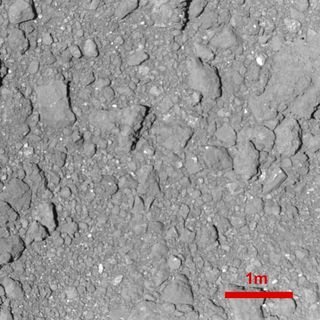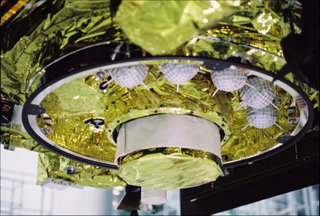Hayabusa2 Braces for a Rocky Landing on Asteroid Ryugu
KNOXVILLE, Tenn. — Japan's Hayabusa2 spacecraft is getting ready to touch down on asteroid Ryugu, where it will scoop a sample of the asteroid's rocky surface that will eventually be sent back to Earth.
After narrowing down the possible landing sites for Hayabusa2, mission scientists performed a sampling rehearsal on Wednesday (Oct. 24) at 10:47 p.m. EST (0247 GMT on Oct. 25), and the mission is "ramping up the steps toward a successful touchdown," Masaki Fujimoto of the Japan Aerospace Exploration Agency (JAXA) said at a news conference here at the 50th meeting of the American Astronomical Society's Division for Planetary Sciences (DPS).
At that time, the spacecraft descended to an altitude of 39 feet (12 meters) above the asteroid's surface and deployed a small target marker at the landing site, Fujimoto said. The spacecraft will go all the way down to the surface to retrieve a sample no earlier than January 2019, and that sample will land in Australia in 2020. [Japan's Hayabusa2 Asteroid Ryugu Sample-Return Mission in Pictures]
The Hayabusa2 mission has already deployed two small hopping rovers (MINERVA-II1A and MINERVA-II1B) and a German lander called the Mobile Asteroid Surface Scout (MASCOT) on Ryugu within the past month. While the MINERVA rovers are still scouting Ryugu's surface, MASCOT's mission was short-lived, ending after only 17 hours and 7 minutes. MASCOT was designed to last only 16 hours on Ryugu's surface.
"The mission focus is now on the successful retrieval and return of a surface sample," officials with the Planetary Science Institute, which is involved with the Hayabusa2 mission, said in a statement. To ensure that this phase of the mission will be a success, mission scientists had to pick a landing site that is not only interesting from a scientific perspective, but that is also safe for the spacecraft — something that proved to be more difficult than mission controllers initially expected.
When Hayabusa2 snapped its first detailed images of Ryugu in June, scientists were "shocked" to find that it's basically a cluster of rubble rather than a smooth, dusty space rock like the asteroid Itokawa (which the original Hayabusa mission visited in 2005) and Eros, Fujimoto said. "That was the moment we realized this was not going to be an easy mission," he said, adding that Ryugu's rocky surface is "not friendly to the mission."

Scientists working on the Hayabusa2 were not prepared for the lack of safe landing sites on Ryugu, because they based their expectations of asteroid Ryugu on past experience, Fujimoto said. "It's not easy to reveal the stupidity that we have been in, but we thought we had good experience with Itokawa … and there was some smooth terrain on the surface, and we thought that's the way it should be. There might be some rocky part but there should be some smoother part and that was the expectation."
Get the Space.com Newsletter
Breaking space news, the latest updates on rocket launches, skywatching events and more!
"This is this is part of why we explore — to see the unexpected and to go ahead and forge ahead and do what we plan to do, return a sample," Deborah Domingue, a participating scientist for Hayabusa2 with the Planetary Science Institute, said in the news conference. "It never meets our expectations wherever we go, and that's the excitement. That's the challenge."
Ryugu's inhospitable terrain proved to be problematic when MASCOT came in for a bumpy landing on Oct. 2. On its way down, the hopping rover crashed into a rock and wound up upside-down with its instruments pointing out into space rather than down at the asteroid's surface, Ralf Jaumann, a principal investigator with the Hayabusa2 mission from the German Aerospace Center (DLR), said at the news conference. Thankfully, the rock was "not too hard," Jaumann said, and mission controllers were able to flip the rover over and carry out all of the investigations as planned.

To find potential sampling sites for Hayabusa2, scientists created topographic models of Ryugu's surface using images from the MINERVA and MASCOT landers and looked for the smoothest areas on the asteroid's surface. "It's pretty much boulders everywhere," said Lucille Le Corre, another participating scientist with the Planetary Science Institute. "There aren't many areas that are smooth."
In addition to the images, scientists are using Hayabusa2's Thermal Infrared Imager (TIR) instrument to learn more about the size and other properties of materials on the asteroid's surface. Specifically, TIR is looking for grains of dust and dirt like those seen on other asteroids and on the moon.
The Hayabusa2 team started out by selecting a square-shaped landing area measuring about 590 feet (180 meters) wide, and they have recently narrowed it to a circle about 66 feet (20 m) in diameter. Now, the next step is to work on improving the spacecraft's navigational accuracy "so that it can hit the hole in one," Fujimoto said. Because Ryugu is about to pass around the opposite side of the sun, causing Hayabusa2 to temporarily lose contact with Earth, "that leaves two months of time for the team to think about the details of the touchdown operations."
Email Hanneke Weitering at hweitering@space.com or follow her @hannekescience. Follow us on Twitter @Spacedotcom and on Facebook. Original article on Space.com.
Join our Space Forums to keep talking space on the latest missions, night sky and more! And if you have a news tip, correction or comment, let us know at: community@space.com.

Hanneke Weitering is a multimedia journalist in the Pacific Northwest reporting on the future of aviation at FutureFlight.aero and Aviation International News and was previously the Editor for Spaceflight and Astronomy news here at Space.com. As an editor with over 10 years of experience in science journalism she has previously written for Scholastic Classroom Magazines, MedPage Today and The Joint Institute for Computational Sciences at Oak Ridge National Laboratory. After studying physics at the University of Tennessee in her hometown of Knoxville, she earned her graduate degree in Science, Health and Environmental Reporting (SHERP) from New York University. Hanneke joined the Space.com team in 2016 as a staff writer and producer, covering topics including spaceflight and astronomy. She currently lives in Seattle, home of the Space Needle, with her cat and two snakes. In her spare time, Hanneke enjoys exploring the Rocky Mountains, basking in nature and looking for dark skies to gaze at the cosmos.